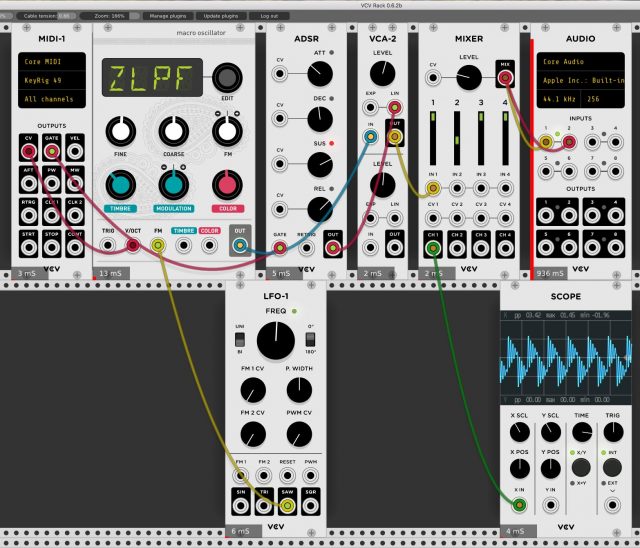
Back in ancient times, synthesizers such as those played by W.W. Carlos and Keith Emerson were assembled from various single-purpose modules, linked together by a multitude of short cables. To change the sound, the musician rearranged the cables and fiddled with the controls on the modules. It was laborious, but with perseverance you could make something like Switched-on Bach or Tarkus. Eventually these modular monsters were replaced by compact synths with fixed architectures, which were easier to program and to transport. Later ones added polyphony and memory for patches, so the musician could play chords and recreate sounds instantly.
Although many of the later synths were immensely useful and desirable, none ever sounded quite like their forebears. Emerson’s modular Moog in particular was legendary. During the past 20 years or so, there’s been increasing interest in modular systems. Notably, the Doepfer “Eurorack” format has become prevalent in certain parts of the electronic music world. A musician can buy whatever modules he wants from a variety of manufacturers and combine them as he pleases. Unfortunately, purchasing modules gets expensive.
However, if you have a reasonably powerful computer, you can run the VCV Rack, a virtual Eurorack. The basic rack, including all you need to make funny noises, is free, and there are many more modules you can download to play with once you get the hang of it, most of which are also free. It’s available here.
I spent several recent lunch hours fiddling with the VCV Rack, and a couple of things quickly became apparent. First, it’s not easy to get an interesting sound out of it. The early synthesists had to work hard to make their music sound good.
Second, videos are the worst way to teach anything. There’s very little text documentation for the rack, so I sat through a number of videos explaining the basics. Good grief, they’re such a waste of time. In principle, videos should be perfect for this job — you can see the connections being made and hear the sounds that result. In practice, you get a guy rambling for half an hour trying to explain something that could have easily been summarized in three minutes. Advice to anyone making an instructional video: before you plug in your microphone, make a detailed written outline of what you want to cover. Better yet, write out what you want to say and skip the video entirely.
*****
Charles G. Hill brings tidings from Japan of a man who “married” a holographic representation of the vocal synthesizer “Hatsune Miku.” Hill linked to a video featuring Miku’s voice which is apparently extremely popular but which doesn’t show what the software is capable of. Here are a couple that better illustrate how a pathetic dweeb could become fixated on the computer-generated image of an anime-style girl: Miku in concert; Miku on a desktop.
Vocal synthesizers, of which Vocaloids are the most successful, occasionally come in handy for those of us with lousy voices. I’ve made use of Miku myself. Others include Plogue’s Alter/Ego and Chipspeech, and Wolfgang Palm’s Phonem.
*****
Francis W. Porretto wonders if anyone remembers Vaughn Meader and David Frye now that their targets are gone. The First Family was before my time, but I do remember hearing one particular skit by Frye frequently at the left end of the FM dial.
*****
It’s been scientifically established that nearly any pop song can be improved by remaking it as a polka or surf tune. In a similar vein, J Greely recently wished that the cast of Dr. Who had turned a recent episode into a Bollywood musical. I haven’t seen that episode so I can’t say for certain, but I expect that would indeed have been an improvement. I suspect, in fact, that most television shows would benefit from being transformed into Bollywood musicals. (Just wondering: are there any Bollywood musical production numbers featuring surf guitar?)
*****
This is terribly unfair, I know, but Cardinal DiNardo in the picture above looks very much like how I visualize Wormtongue when I read The Lord of the Rings.


Would I have paid actual yen to see Miku-san “live”?
Yes, I think I would have.